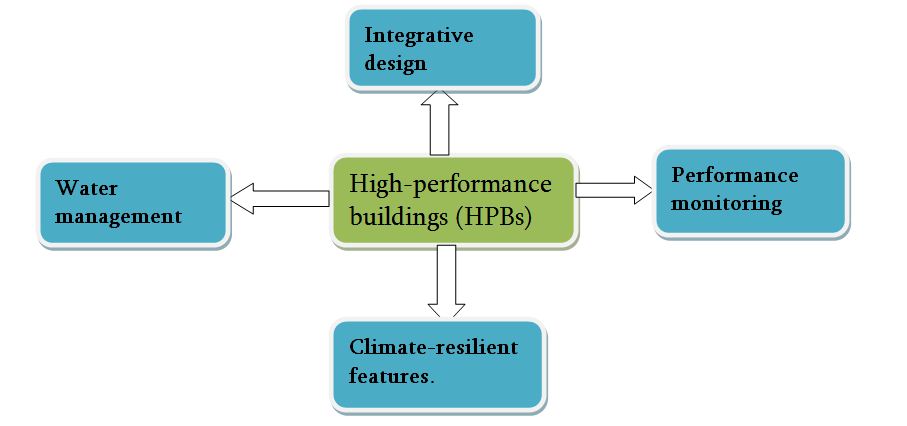November 19, 2024
What is High-performance buildings (HPBs)?उच्च प्रदर्शन वाली इमारतें (एचपीबी)
High-performance buildings (HPBs)/How can design help a building be more climate-resilient?
High-performance buildings are at the forefront of sustainable construction, focusing on energy efficiency, resource conservation, and climate resilience through integrative design and the use of sustainable materials; they employ passive and active strategies to minimise environmental impact
What are High-performance buildings (HPBs)?
High-performance buildings (HPBs) are structures designed to deliver superior levels of energy efficiency, sustainability, comfort, and operational performance.
- High-performance buildings (HPBs) are at the forefront of sustainable construction, tackling urgent needs like energy efficiency, climate resilience and resource conservation. As climate change intensifies, resources become scarcer, and urbanisation increases, HPBs — built to consume less energy, conserve resources, and withstand unpredictable weather — are an important part of achieving and keeping sustainable living.
- Building an HPB requires key practices such as integrative design, lifecycle-based materials, efficient energy and water management, performance monitoring, and climate-resilient features.

What is integrative design?
- At the core of HPBs is an integrative design approach that encourages architects, engineers, sustainability consultants, and building owners to work together and set measurable performance goals.
- These goals might aim for, say, 90% daylighting in occupied spaces or cooling in 700 sq. ft. per tonne of air-conditioning in commercial buildings. This approach ensures all building systems — air-conditioning, lighting, and building envelope components like walls, roofs, and windows — work together smoothly.
- Digital modelling also plays a crucial role by creating a virtual representation of the project, allowing the team to predict performance outcomes, guide optimal system sizing, and test different strategies. With simulations, the team can adjust their strategies to meet energy-saving and thermal comfort goals before construction even begins. This predictive approach helps achieve high operational efficiency, improves resilience, and reduces long-term costs.
- An example of an integrative design process in HPBs is the early use of passive design strategies, whereby designers make the most of natural sunlight and plan to use materials that retain heat (thermal mass). These strategies reduce heating and cooling demands, allowing designers to choose equipment of the right size.
उच्च प्रदर्शन वाली इमारतें (एचपीबी)/डिजाइन कैसे किसी इमारत को जलवायु के प्रति अधिक लचीला बनाने में मदद कर सकता है?
उच्च प्रदर्शन वाली इमारतें टिकाऊ निर्माण में सबसे आगे हैं, जो एकीकृत डिजाइन और टिकाऊ सामग्रियों के उपयोग के माध्यम से ऊर्जा दक्षता, संसाधन संरक्षण और जलवायु लचीलापन पर ध्यान केंद्रित करती हैं; वे पर्यावरणीय प्रभाव को कम करने के लिए निष्क्रिय और सक्रिय रणनीतियों को अपनाती हैं
उच्च प्रदर्शन वाली इमारतें (एचपीबी) क्या हैं?
- उच्च प्रदर्शन वाली इमारतें (एचपीबी) ऐसी संरचनाएं हैं जिन्हें ऊर्जा दक्षता, स्थिरता, आराम और परिचालन प्रदर्शन के बेहतर स्तर प्रदान करने के लिए डिज़ाइन किया गया है।
- उच्च प्रदर्शन वाली इमारतें (एचपीबी) टिकाऊ निर्माण में सबसे आगे हैं, जो ऊर्जा दक्षता, जलवायु लचीलापन और संसाधन संरक्षण जैसी तत्काल आवश्यकताओं को पूरा करती हैं। जैसे-जैसे जलवायु परिवर्तन तीव्र होता है, संसाधन कम होते जाते हैं और शहरीकरण बढ़ता है, एचपीबी – कम ऊर्जा की खपत करने, संसाधनों को संरक्षित करने और अप्रत्याशित मौसम का सामना करने के लिए बनाए गए – टिकाऊ जीवन को प्राप्त करने और बनाए रखने का एक महत्वपूर्ण हिस्सा हैं।
- HPB के निर्माण के लिए एकीकृत डिजाइन, जीवनचक्र-आधारित सामग्री, कुशल ऊर्जा और जल प्रबंधन, प्रदर्शन निगरानी और जलवायु-लचीली विशेषताओं जैसी प्रमुख प्रथाओं की आवश्यकता होती है।
एकीकृत डिजाइन क्या है?
- HPB के मूल में एक एकीकृत डिजाइन दृष्टिकोण है जो वास्तुकारों, इंजीनियरों, स्थिरता सलाहकारों और भवन मालिकों को एक साथ काम करने और मापने योग्य प्रदर्शन लक्ष्य निर्धारित करने के लिए प्रोत्साहित करता है।
- ये लक्ष्य, उदाहरण के लिए, कब्जे वाले स्थानों में 90% दिन के उजाले या वाणिज्यिक भवनों में प्रति टन एयर-कंडीशनिंग के लिए 700 वर्ग फीट में शीतलन का लक्ष्य रख सकते हैं। यह दृष्टिकोण सुनिश्चित करता है कि सभी बिल्डिंग सिस्टम – एयर-कंडीशनिंग, लाइटिंग और बिल्डिंग लिफ़ाफ़े के घटक जैसे दीवारें, छत और खिड़कियाँ – एक साथ सुचारू रूप से काम करें।
- डिजिटल मॉडलिंग भी परियोजना का एक आभासी प्रतिनिधित्व बनाकर एक महत्वपूर्ण भूमिका निभाता है, जिससे टीम को प्रदर्शन परिणामों की भविष्यवाणी करने, इष्टतम सिस्टम आकार निर्धारण का मार्गदर्शन करने और विभिन्न रणनीतियों का परीक्षण करने की अनुमति मिलती है। सिमुलेशन के साथ, टीम निर्माण शुरू होने से पहले ऊर्जा-बचत और थर्मल आराम लक्ष्यों को पूरा करने के लिए अपनी रणनीतियों को समायोजित कर सकती है। यह पूर्वानुमानित दृष्टिकोण उच्च परिचालन दक्षता प्राप्त करने, लचीलेपन में सुधार करने और दीर्घकालिक लागतों को कम करने में मदद करता है।
- एचपीबी में एकीकृत डिजाइन प्रक्रिया का एक उदाहरण निष्क्रिय डिजाइन रणनीतियों का प्रारंभिक उपयोग है, जिसके तहत डिजाइनर प्राकृतिक सूर्य के प्रकाश का अधिकतम उपयोग करते हैं और ऐसी सामग्रियों का उपयोग करने की योजना बनाते हैं जो गर्मी (थर्मल द्रव्यमान) को बनाए रखती हैं। ये रणनीतियाँ हीटिंग और कूलिंग की माँग को कम करती हैं, जिससे डिज़ाइनर सही आकार के उपकरण चुन सकते हैं।
January 30, 2025
January 20, 2025
January 14, 2025
